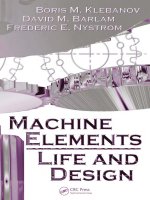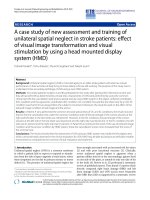Machine fault diagnois and condition prognois using adaptive neuro fuzzy inference system and classification and regression trees
Bạn đang xem bản rút gọn của tài liệu. Xem và tải ngay bản đầy đủ của tài liệu tại đây (1.2 MB, 10 trang )
Thesis for the Degree of Doctor of Philosophy
Machine Fault Diagnosis and Condition
Prognosis using Adaptive Neuro-Fuzzy Inference
System and Classification and Regression Trees
by
Van Tung Tran
Department of Mechanical Engineering
The Graduate School
Pukyong National University
February 2009
Machine Fault Diagnosis and Condition
Prognosis using Adaptive Neuro-Fuzzy Inference
System and Classification and Regression Trees
기계 결함진단 및 예지를 위한 ANFIS 와 CART
Advisor: Prof. Bo-Suk Yang
by
Van Tung Tran
A thesis submitted in partial fulfillment of the requirements
for the degree of
Doctor of Philosophy
in the Department of Mechanical Engineering, The Graduate School,
Pukyong National University
February 2009
Contents
List of Figures ..........................................................................................................v
List of Tables ....................................................................................................... viii
List of Symbols ...................................................................................................... ix
Abstract
.............................................................................................................
I. Introduction ................................................................................................ 1
1. Background ........................................................................................... 1
2. Motivation of This Research ................................................................. 6
3. Research Objectives .............................................................................. 6
4. Tools and Approaches........................................................................... 7
5. Scientific Contribution of This Research.............................................. 7
6. Organization of Thesis .......................................................................... 8
References .................................................................................................. 9
II. The State-of-The-Art of Machine Fault Diagnosis and Prognosis ......... 11
1. Machine Fault Diagnosis .................................................................... 11
1.1. Model-based approaches........................................................................11
1.2. Knowledge-based approaches................................................................13
1.3. Pattern recognition-based approaches ...................................................15
2. Machine Fault Prognosis..................................................................... 19
2.1. Statistical approaches .............................................................................20
2.2. Model-based approaches........................................................................21
2.3. Data-driven based approaches ...............................................................22
References ................................................................................................ 22
i
III. Background Knowledge ........................................................................ 36
1. Feature-Based Diagnosis and Prognosis: a Review ............................ 36
1.1. Feature extraction techniques ................................................................37
1.2. Feature selection techniques ..................................................................39
2. Feature Representation........................................................................ 40
2.1. Features in time domain .........................................................................40
2.1.1. Cumulants.......................................................................................40
2.1.2. Upper and lower bound histogram .................................................44
2.1.3. Entropy estimation and error ..........................................................45
2.1.4. Auto-regression coefficients ..........................................................45
2.2. Feature in frequency domain .................................................................46
2.2.1. Fourier transform............................................................................46
2.2.2. Spectral analysis .............................................................................47
2.2.3. Frequency parameter indices ..........................................................48
3. Classification and Regression Trees (CART) ..................................... 49
3.1. Introduction ............................................................................................49
3.2. Tree growing ..........................................................................................50
3.2.1. Classification tree ...........................................................................50
3.2.2. Regression tree ...............................................................................52
3.3. Tree pruning ...........................................................................................54
3.3.1. Classification tree ...........................................................................54
3.3.2. Regression tree ...............................................................................55
3.4. Cross-validation for selecting the best tree ............................................56
4. Adaptive Neuro-Fuzzy Inference System (ANFIS)............................ 57
4.1. Architecture of ANFIS...........................................................................57
4.2. Learning algorithm of ANFIS................................................................60
5. Conclusions ......................................................................................... 61
ii
References ................................................................................................ 61
IV. CART and ANFIS Based Fault Diagnosis for Induction Motors ......... 67
1. Introduction ......................................................................................... 67
2. Induction Motor Faults ....................................................................... 67
2.1. Bearing faults .........................................................................................70
2.2. Stator or armature faults ........................................................................72
2.3. Broken rotor bar and end ring faults ......................................................74
2.4. Eccentricity related faults ......................................................................75
3. The Proposed Fault Diagnosis System for Induction Motors ............. 77
3.1. Experiment and data acquisition ............................................................79
3.2. Feature calculation .................................................................................81
3.3. Feature selection and classification .......................................................83
4. Conclusion .......................................................................................... 90
References ................................................................................................ 91
V. Machine Condition Prognosis ................................................................ 94
1. Introduction ......................................................................................... 94
2. Prediction Strategies ........................................................................... 97
2.1. Recursive prediction strategy.................................................................97
2.2. DirRec prediction strategy .....................................................................98
2.3. Direct prediction strategy.......................................................................98
3. Time Delay Estimation ....................................................................... 99
4. Determining Embedding Dimension ................................................ 100
4.1. Cao’s method .......................................................................................100
4.2. False nearest neighbor method (FNN) .................................................101
5. Proposed System for Machine Condition Prognosis ........................ 103
6. Experiment ........................................................................................ 105
iii
7. Case Studies of Machine Condition Prognosis ................................. 108
7.1. Case study 1: CART and OS prediction ..............................................108
7.2. Case study 2: parallel CART and MS direct prediction ......................115
7.2.1. Parallel structure of CART ...........................................................115
7.2.2. Results and discussions ................................................................116
7.3. Case study 3: ANFIS and MS direct prediction ..................................124
8. Conclusions ....................................................................................... 130
References .............................................................................................. 132
VI. Conclusions and Future Works ........................................................... 134
1. Conclusions ....................................................................................... 134
2. Future Works..................................................................................... 135
Acknowledgements .........................................................................................
iv
List of Figures
Fig. 1.1
System costs depending on type of maintenance strategy ....................3
Fig. 1.2
Architecture of a CBM system .............................................................4
Fig. 3.1
Histogram for bearing signal with different condition .......................44
Fig. 3.2
Classification tree .............................................................................51
Fig. 3.3
Regression tree ...................................................................................53
Fig. 3.4
Schematic of ANFIS architecture .......................................................58
Fig. 4.1
View of a squirrel cage induction motor ............................................68
Fig. 4.2
Four types of rolling-element bearing misalignment .........................70
Fig. 4.3
Bearing sizes marked ..........................................................................71
Fig. 4.4
Proposed system for fault diagnosis ...................................................78
Fig. 4.5
Test rig for experiment .......................................................................79
Fig. 4.6
Faults on the induction motors ...........................................................80
Fig. 4.7
Vibration and current signals of each fault condition.........................81
Fig. 4.8
Decision tree of features obtained from vibration signal ...................84
Fig. 4.9
Decision tree of features obtained from current signal.......................84
Fig. 4.10
Topology of ANFIS architecture for vibration signals .......................85
Fig. 4.11
The network RMS error convergence curve.......................................86
Fig. 4.12
Bell shaped membership functions for vibration signals....................87
Fig. 5.1
Hierarchy of prognostic approaches ...................................................96
Fig. 5.2
Proposed system for machine fault prognosis ..................................104
Fig. 5.3
Low methane compressor: wet screw type .......................................105
Fig. 5.4
The entire of peak acceleration data of low methane compressor ..........
..........................................................................................................106
v
Fig. 5.5
The entire of envelope acceleration data of low methane compressor
..........................................................................................................107
Fig. 5.6
The faults of main bearings of compressor ......................................108
Fig. 5.7
Training and validating results of peak acceleration data (the first 300
points) ...............................................................................................109
Fig. 5.8
Predicted results of peak acceleration data .......................................110
Fig. 5.9
Peak acceleration of low methane compressor .................................110
Fig. 5.10
The values of E1 and E2 of peak acceleration data of low methane
compressor .......................................................................................111
Fig. 5.11
Training and validating results of peak acceleration data ................112
Fig. 5.12
Predicted results of peak acceleration data .......................................112
Fig. 5.13
Data trending of envelope acceleration of low methane compressor
..........................................................................................................113
Fig. 5.14
The values of E1 and E2 of envelope acceleration data ...................114
Fig. 5.15
Training and validating results of envelope acceleration data ...............
..........................................................................................................114
Fig. 5.16
Predicted results of envelope acceleration data ................................115
Fig. 5.17
Architecture and input values for sub-model of parallel-structure of
CART ...............................................................................................116
Fig. 5.18
Time delay estimation ......................................................................117
Fig.5.19
The
relationship
between
FNN
percentage
and
embedding
dimension .........................................................................................118
Fig. 5.20
Training and validating results of peak acceleration data ................120
Fig. 5.21
Training and validating results of envelop acceleration data ...........121
Fig. 5.22
Predicted results of peak acceleration data .......................................123
Fig. 5.23
Predicted results of envelop acceleration data ..................................124
Fig. 5.24
Training and validating results of the ANFIS model for peak
acceleration data ...............................................................................126
vi
Fig. 5.25
Training and validating results of the ANFIS model for envelope
acceleration data ...............................................................................126
Fig. 5.26
RMSE convergent curve ...................................................................127
Fig. 5.27
The changes of MFs after learning ...................................................128
Fig. 5.28
Predicted results of ANFIS model for peak acceleration data................
..........................................................................................................129
Fig. 5.29
Predicted results of the ANFIS model for envelope acceleration data
..........................................................................................................130
Fig. 6.1
The general hybrid system ................................................................136
vii







![[Khiem] improvement of matrix converter drive reliability by online fault detection and a fault tolerant switching strategy IEEE trans](https://media.store123doc.com/images/document/14/y/ib/medium_ibr1399917315.jpg)

